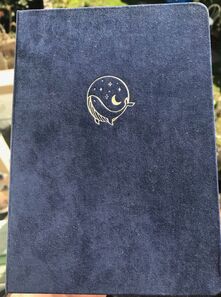Silver Wordsmith: An author's journey |

If my writing projects are any indication, when I’m presented with something shiny I get easily distracted. Apparently the same goes for my bullet journals. I’ve talked about my bullet journaling once in a while – first describing my main bujo and then highlighting some of its specific entries. I had been using my current one for four years, with different logs coming and going, but my writing logs being my favourite ones since they play a large part in my writing tracking and motivation.
Now comes this past Christmas, and my best friend gifts me a gorgeous new bullet journal, with a rich velvety cover.
Naturally, when presented with a new bujo, one must find a way to utilize it immediately (please don’t tell the several pristine journals sitting in my closet), so I decided to break away my writing trackers, and make this new one exclusively a writing bujo. My previous tracker called “10,000 Hours”, which tracks progress per project and ancillary activity, and “Wordsmithing” which is a heat map of daily word counts, will now live in this new journal.
The migration of the two trackers also allows me to switch things up a bit as I start afresh. Here’s the new entry, sadly with no room available for the title:
The main difference with this one is I took this opportunity to expand the number of columns. In my previous bujo, it had to share space with many trackers, whereas here, it would take up the majority of the journal. This gave me the space to add additional columns such as “promotion” which is when I do something that expands my online profile. It also gives me a buffer to be able to add new projects as well, given that I will keep a constant three months per two-page spread ratio. The intent is to be able to use this bujo for a full decade, and I wanted to make sure when I was adapting this tracker that it would be relatively future-proof.
The changes to the Words Per Day tracker is also largely informed by future-proofing. The two major changes here were expanding the number of word ranges represented by separate colours, and changing the colours themselves. The colour changes are relatively self-explanatory, with the added task of making sure each square is more easily identifiable.  One of these squares is allegedly purple One of these squares is allegedly purple
I noticed in the last iteration that the purple blended in with the blue and was nearly impossible to spot. So I played around on the last page of the journal to preview the colour contrast and came up with this new heatmap.
Now here’s where the future-proofing comes in – previously, the highest category was over 2000 words per day and now I’ve split this off into three: 2,000 – 2,999, 3,000 – 4,999 and over 5,000. These new thresholds are very ambitious, considering that I have written over 2,000 words in a day only a couple of times in the last few years. But I intend for this journal to last twelve years, and the fool’s hope is that at some point during this time period I could get to the point where I’m able to occasionally write over 5,000 words in a single day. Thank you for indulging me in my little bujo rant. I hope the few of you that are here because of bullet journal entries enjoyed it. And for the writers out there, if you hadn’t seen my trackers until now, hope some of you have gotten ideas for your own way of tracking productivity.
0 Comments
Leave a Reply. |
Michael SerebriakovMichael is a husband, father of three, lawyer, writer, and looking for that first big leap into publishing. All opinions are author's own. StoriesUrsa Major Categories
All
Archives
January 2024
|
Proudly powered by Weebly
 RSS Feed
RSS Feed